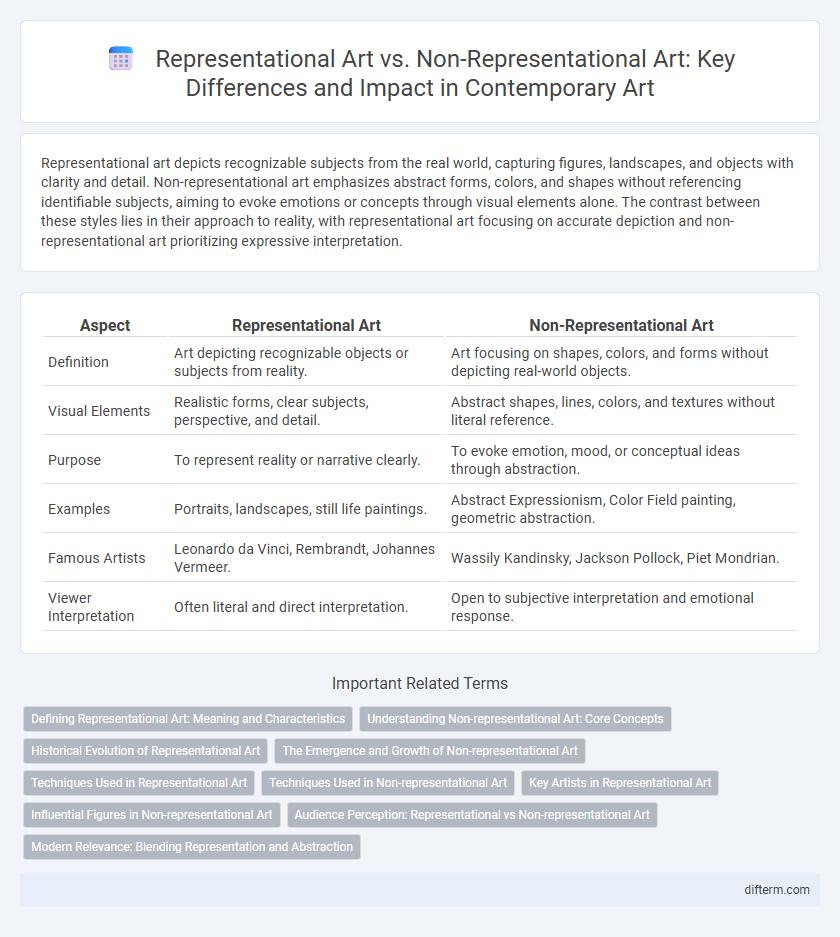Representational art depicts recognizable subjects from the real world, capturing figures, landscapes, and objects with clarity and detail. Non-representational art emphasizes abstract forms, colors, and shapes without referencing identifiable subjects, aiming to evoke emotions or concepts through visual elements alone. The contrast between these styles lies in their approach to reality, with representational art focusing on accurate depiction and non-representational art prioritizing expressive interpretation.
Table of Comparison
| Aspect | Representational Art | Non-Representational Art |
|---|---|---|
| Definition | Art depicting recognizable objects or subjects from reality. | Art focusing on shapes, colors, and forms without depicting real-world objects. |
| Visual Elements | Realistic forms, clear subjects, perspective, and detail. | Abstract shapes, lines, colors, and textures without literal reference. |
| Purpose | To represent reality or narrative clearly. | To evoke emotion, mood, or conceptual ideas through abstraction. |
| Examples | Portraits, landscapes, still life paintings. | Abstract Expressionism, Color Field painting, geometric abstraction. |
| Famous Artists | Leonardo da Vinci, Rembrandt, Johannes Vermeer. | Wassily Kandinsky, Jackson Pollock, Piet Mondrian. |
| Viewer Interpretation | Often literal and direct interpretation. | Open to subjective interpretation and emotional response. |
Defining Representational Art: Meaning and Characteristics
Representational art depicts recognizable subjects from the real world, emphasizing accurate or stylized portrayal of people, objects, and scenes. This art form prioritizes visual clarity and concrete imagery, often aiming to capture physical reality or emotional resonances through identifiable figures. Key characteristics include naturalism, perspective, and detailed rendering, which distinguish representational art from abstract or non-representational styles.
Understanding Non-representational Art: Core Concepts
Non-representational art emphasizes pure visual elements such as color, form, and texture without depicting recognizable objects or scenes, challenging traditional notions of artistic representation. This art form encourages viewers to experience emotions and ideas directly through abstract compositions rather than relying on figurative references. Core concepts include abstraction, expressionism, and the exploration of visual language as an autonomous entity independent from literal interpretation.
Historical Evolution of Representational Art
Representational art, rooted in ancient civilizations such as Mesopotamia and Ancient Egypt, evolved through the Classical period emphasizing realistic human forms and perspectives. The Renaissance marked a pivotal advancement with artists like Leonardo da Vinci and Michelangelo pioneering techniques in anatomy and linear perspective to enhance the lifelike quality of their work. This historical evolution reflects a continuous pursuit of realism, contrasting with the later emergence of non-representational art that prioritizes abstraction and form over direct depiction.
The Emergence and Growth of Non-representational Art
Non-representational art emerged in the early 20th century as artists like Wassily Kandinsky and Piet Mondrian explored abstraction beyond recognizable forms, prioritizing color, shape, and emotion. This movement marked a shift from traditional representational art that depicted real-world objects to artworks focused on conveying ideas and feelings through non-figurative means. The growth of non-representational art significantly influenced modern art, leading to diverse styles such as abstract expressionism and minimalism.
Techniques Used in Representational Art
Representational art employs techniques such as chiaroscuro to create depth and volume, and linear perspective to depict spatial relationships accurately. Artists often use detailed brushwork and color blending to render lifelike textures and natural forms. These methods aim to reproduce real-world scenes with precision, enhancing the viewer's perception of realism and familiarity.
Techniques Used in Non-representational Art
Non-representational art employs techniques such as bold color application, geometric shapes, and dynamic brushstrokes to evoke emotions and ideas beyond literal depiction. Artists often utilize layering, abstraction, and unconventional materials to create texture and depth, emphasizing form and composition over recognizable subjects. These methods challenge traditional perspectives and invite viewers to engage with the artwork through interpretation and personal experience.
Key Artists in Representational Art
Key artists in representational art include Leonardo da Vinci, whose detailed anatomical studies and realistic portraits set foundational standards, and Johannes Vermeer, renowned for his masterful use of light to depict intimate domestic scenes. Diego Velazquez's dynamic compositions and Bartolome Esteban Murillo's vivid religious imagery further exemplify the depth and diversity of representational techniques. These artists collectively emphasize accurate visual representation, capturing tangible reality through precise detail and perspective.
Influential Figures in Non-representational Art
Influential figures in non-representational art include Wassily Kandinsky, often regarded as a pioneer of abstract art, who emphasized the spiritual and emotional impact of color and form independent of visual reality. Piet Mondrian contributed significantly with his development of De Stijl, focusing on geometric abstraction and primary colors to express universal harmony. Kazimir Malevich's Suprematism introduced pure artistic feeling through basic geometric shapes, challenging traditional representation and emphasizing the supremacy of artistic expression over visual accuracy.
Audience Perception: Representational vs Non-representational Art
Representational art allows audiences to easily identify subjects, fostering immediate emotional connections and narrative understanding through recognizable imagery. Non-representational art challenges viewers to interpret shapes, colors, and forms subjectively, encouraging personal reflection and diverse emotional responses. Audience perception varies as representational works guide meaning explicitly, while non-representational pieces invite open-ended interpretation and active engagement.
Modern Relevance: Blending Representation and Abstraction
Modern art frequently blends representational and non-representational elements to challenge traditional visual boundaries and evoke complex emotional responses. This hybrid approach allows artists to retain recognizable imagery while integrating abstract forms to emphasize conceptual ideas and subjective experiences. Such fusion reflects contemporary cultural dynamics, redefining artistic expression and expanding the scope of visual communication.
Representational art vs Non-representational art Infographic

 difterm.com
difterm.com